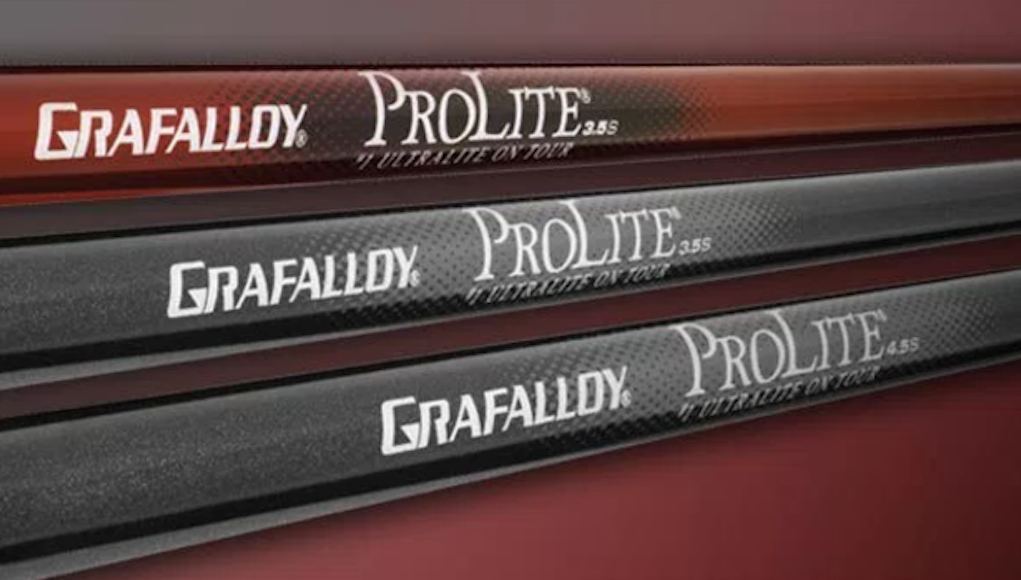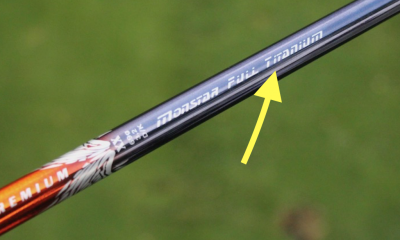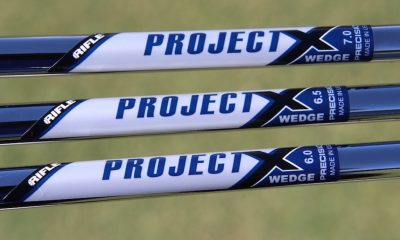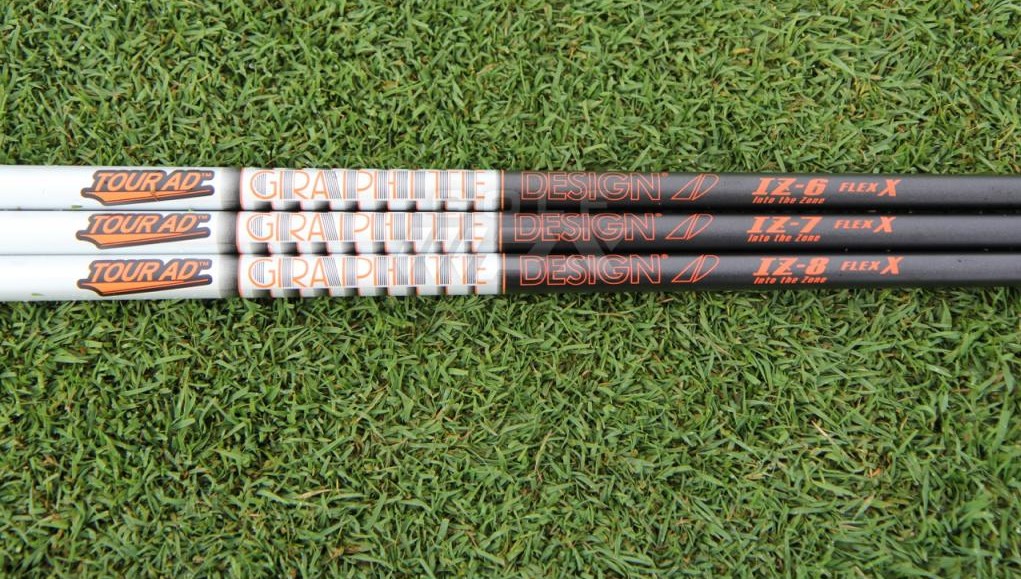Opinion & Analysis
Flex Appeal: An interview with shaft guru Robin Arthur

Life has a funny way of throwing people together. I was recently surfing the web, researching a new shaft for my driver. I sent off a few emails to shaft companies and OEM component companies asking for some advice. To my surprise, they all answered and had useful suggestions. But the response that captured my attention most was from Arthur Xtreme Engineering, a company that designs, tests and markets the Xcaliber brand of golf shafts. I received an email from Robin Arthur asking me a bunch of questions. Turns out he’s the CEO and President, so I was nice getting some VIP treatment!
I did a bit of Googling on Robin and, to my surprise, a ton of stuff came up. He’s a bit of a rockstar in the world of golf shafts, known in golfing circles as the King of the Lightweight Shaft, as his Grafalloy Prolite shafts are tagged as the “winningest ultralite shaft in Tour history,” according to multiple sources.
He’s now his own boss at Arthur Xtreme Engineering and XCaliber Shafts (King Arthur, remember!) and some of his YouTube videos, like this one, make compelling viewing. But don’t let this self-styled, West Virginian fool you. He’s a smart guy with degrees in engineering, applied science and business from Yale.
I recently caught up with Robin in his office in San Diego. A scheduled 30-minute interview turned into a fascinating two-hour journey covering grounds on all sorts of interesting and educational topics. I have tensile strength, modularity, fiber and resin content coming out of my ears. It’s hard not to feel the sense of enthusiasm with “King Arthur.”
Editor’s Note: This Q&A has been edited for clarity and brevity.
Mark Donaghy: What’s your background, Robin?
Robin Arthur: After college I spent my early years working in the aerospace industry, joining General Dynamics in 1982. I was involved in many, many programs designing and manufacturing aerospace composite structures. The evolution of graphite and epoxy materials were critical keys. They led to advancements in reducing weight while maintaining strength, opening doors to next generation design and manufacturing techniques. And I was at the forefront of all that.
MD: It’s a big transition from rockets to golf shafts. So how did that come about?
RA: Well, not really. I saw the opportunity to bring my knowledge and experience into another industry, one that was crying out for it. At that time I had just started playing golf and I was obsessed by the game. I was headhunted for a role in Grafalloy, a relatively unknown company in California, to breathe some life into it with innovative R&D and manufacturing. Graphite shafts had really just taken off, so you could say I was in the right place at the right time.
MD: When starting out in the industry, what did you think you could bring to the game of golf that was different, and do you feel you accomplished that?
RA: When I first started in the golf industry, I met a lot of people and asked a lot of questions. I spoke with all the major OEMs and saw what was available in the market and the claims that some of the existing shaft companies were making. I quickly began to realize that there was huge opportunity to improve on what was out there. Both manufacturing and design processes were archaic and resulted in shaft inconsistencies. I knew with my materials, science and engineering background, and experience in the aerospace industry, I could develop something lighter and more consistent, but I had to put some fundamental processes in place first and that took a few years. I’ve always seen myself as an “imagineer” — seeing the art of the possible — and I am constantly challenging both myself and the industry with new concepts. A lot of the stuff I’ve come up with has never made it to market, but I think my lightweight designs have held their own in the industry and then some.
MD: Why lightweight shafts?
RA: Lightweight shafts were originally targeted at the Asian, senior and ladies markets. They allowed more speed to be generated and the dampening properties of graphite meant they were easier on the joints. I tested some of these shafts, and although really whippy, I thought once the guys on the senior tour got hold of them, they would take off. The problem was getting something to play in the No. 1 head on all Tours – The Great Big Bertha. It was a great, titanium head concept….except the distribution of mass wasn’t….ummm….optimal. What some of the shaft companies were doing was sanding down an X-flex shaft to an R-flex, sometimes all the way to an L-flex, taking off 20g of weight and making it almost impossible to do it consistently. Some OEMs were using lighter weight grips (The Bubble) and altering the distribution of mass in the clubhead. Remember the Great Big Bertha? The pros were still putting the ball in orbit with four and five degrees of loft. The problem Callaway was having with the Great Big Bertha was the mass distribution of properties (weight, etc.) of that head design. This was complicated by the distribution of stiffness along the length of the shaft that existing shaft companies used. It took a while to get it right, but when I did, things really took off.
MD: With all your successes at Grafalloy, what keeps you going?
RA: I love golf and I love helping people, be it a tour professional, a club maker or the regular guy on the street. I get a kick out of helping someone get the right shaft to match their game, making it a lot more enjoyable. I really enjoy getting feedback that a shaft has made a big difference. So the pursuit of designing and manufacturing the best shafts available on the market always drives me. Also, being able to offer that at a realistic price is a fundamental cornerstone to my philosophy.
But here’s the real bottom line. I grew up as an athlete and performed at a high level. Every day I worked on becoming a better athlete, every single day. I take this same approach of continuous improvement to my shaft designs, marketing approaches and even pricing. That’s what gets me out of bed in the morning!
MD: What’s next with Xcaliber?
RA: Since leaving Grafalloy, I’ve been involved in several projects. I’ve worked with shaft companies like Royal Precision, Wishon Golf, and Golfworks, and served as a consultant to smaller OEMs. I also took a bit of a hiatus to follow some personal ambitions. But I’m now energized to really get going again with Xcaliber. For a few years I was running a one-man show, doing the R&D, the manufacturing, sales and marketing all by myself. But I’ve turned a corner. I have a whole new line-up of shafts coming out for 2017, and I’m excited. In fact, I’m just back after some extensive player testing all over the U.S., and with Gene Parente at Golf Labs. The results look awesome! So I’m ready to start scaling up. I’ve invested a lot of resources in new management and marketing, and I want to set up channels not just in the U.S., but also Europe and Asia. And I want to take that to the world with a reasonably priced product. Watch out for me in Orlando at the PGA Merchandise show. I’ll be the guy with the big smile on his face!
MD: What do you see as the next shaft developments over the next 10-20 years?
RA: The (golf) head guys have so many restrictions these days that it’s hard to see any major developments there in the near future. The only real way to improve is with the shaft. Luckily the launch monitors are getting so good these days that measuring shaft performance has become a lot more scientific. This is great because it allows me to give the golfing community objective differences in shaft designs. When this info is combined with subjective feedback from extensive player testing, which is just as important as in-lab testing, I can feel confident putting my name on an Xcaliber golf shaft. That’s because I know it’s the best, high-performance shaft I can make for a particular golfer.
I’m always experimenting with new, exotic materials no one has ever heard of before and continuing to blend existing materials such as steel, fibreglass and graphite epoxy in innovative ways. So lighter, stronger shafts will continue to grow in popularity. Also geometry will be a major development but I can’t say too much about that for now. Watch this space!
MD: Where do you get your inspiration?
RA: I already described myself as an imagineer. Technically I’m pretty good across the board, but I’m more of a concepts guy. My latest project came from watching a Zorro movie. When Antonio Banderas cracked his bull whip, it got me thinking about the angular acceleration of the lower portion a shaft, and immediately I was off developing a new concept. I also get ideas from the questions I ask. But like they say, genius is only 1 percent inspiration and 99 percent perspiration. It’s funny…I’m constantly doing the perspiration part. Maybe someday I’ll get a glimpse of that genius thing.
MD: Over the years, have you worked on any special projects with any high-profile golfers?
RA: I’ve been lucky to have worked with a bunch of PGA Tour players, and of course, players of all abilities. I’ve learned from them all. But one of the biggest highlights in my career was working with Gary Player at Augusta. Mr. Player was in his early 60s and could still hit the snot out of his driver. He had heard about the Prolite shaft and asked me to get him a couple for his Bridgestone heads. He wanted to do a head-to-head comparison with his current gamer, and at the start he was skeptical. It came down to four shots, two with his current set up and two with the Prolite. He asked Peter Brooks, the CFO of Grafalloy at the time, to head down to the fairway to measure and mark the shots. Mr. Player hit his first two shots about 250 yards down the fairway and then indicated he was going to try my Prolite. I watched as his first drive sailed over Pete’s head! After Peter walked to the longer mark, Mr. Player’s second shot sailed over his head again! I wish I could have videoed Gary’s expression…and my smile. He leaned over to me afterwards and whispered, “Robin, I think you may be onto something big here with this shaft. I’ll take ‘em.” They weren’t even for sale!
MD: What sort of golfer are you?
RA: I’d love to tell you I was a scratch golfer, but the truth is that these days I play off about a 10 index. At one point I played to about 4, but right now all my energy is going into developing the business. Twelve- to 14-hour days mean I don’t get to play as often as I like, maybe only two or three times per month. It’s around the greens where I suffer. But I test a bunch of clubs. I’m a “testaholic,” and I can hit a ball well enough to know the difference. I then pass along those shafts I think are good enough to my testing teams who help me either continue the design process or say, “We’ve got it!”
MD: What clubs/shafts do you currently game?
RA: As you might expect, all my clubs have Xcaliber shafts in them, but because I am continuously testing clubs my bag is never the same. I do always carry a Maltby Tricept 58-degree with one of my Spin Wedge shafts in it. I’m getting 2000 rpm more spin with setup because of whip action in the shaft. I love that club! I can stop it on a dime. But I’m forever testing new heads with new shaft combinations so I’m usually grabbing what’s near, or what’s in test and heading out.
MD: Thanks, Robin. My brain hurts. Can I go now?
RA: Yes, go forth, newly appointed Sir Knight. The battle rages, so spread the word.
Have shaft questions for Arthur? He can be contacted at robin@xcalibershafts.com.
Opinion & Analysis
The 2 primary challenges golf equipment companies face

As the editor-in-chief of this website and an observer of the GolfWRX forums and other online golf equipment discourse for over a decade, I’m pretty well attuned to the grunts and grumbles of a significant portion of the golf equipment purchasing spectrum. And before you accuse me of lording above all in some digital ivory tower, I’d like to offer that I worked at golf courses (public and private) for years prior to picking up my pen, so I’m well-versed in the non-degenerate golf equipment consumers out there. I touched (green)grass (retail)!
Complaints about the ills of and related to the OEMs usually follow some version of: Product cycles are too short for real innovation, tour equipment isn’t the same as retail (which is largely not true, by the way), too much is invested in marketing and not enough in R&D, top staffer X hasn’t even put the new driver in play, so it’s obviously not superior to the previous generation, prices are too high, and on and on.
Without digging into the merits of any of these claims, which I believe are mostly red herrings, I’d like to bring into view of our rangefinder what I believe to be the two primary difficulties golf equipment companies face.
One: As Terry Koehler, back when he was the CEO of Ben Hogan, told me at the time of the Ft Worth irons launch, if you can’t regularly hit the golf ball in a coin-sized area in the middle of the face, there’s not a ton that iron technology can do for you. Now, this is less true now with respect to irons than when he said it, and is less and less true by degrees as the clubs get larger (utilities, fairways, hybrids, drivers), but there remains a great deal of golf equipment truth in that statement. Think about it — which is to say, in TL;DR fashion, get lessons from a qualified instructor who will teach you about the fundamentals of repeatable impact and how the golf swing works, not just offer band-aid fixes. If you can’t repeatably deliver the golf club to the golf ball in something resembling the manner it was designed for, how can you expect to be getting the most out of the club — put another way, the maximum value from your investment?
Similarly, game improvement equipment can only improve your game if you game it. In other words, get fit for the clubs you ought to be playing rather than filling the bag with the ones you wish you could hit or used to be able to hit. Of course, don’t do this if you don’t care about performance and just want to hit a forged blade while playing off an 18 handicap. That’s absolutely fine. There were plenty of members in clubs back in the day playing Hogan Apex or Mizuno MP-32 irons who had no business doing so from a ballstriking standpoint, but they enjoyed their look, feel, and complementary qualities to their Gatsby hats and cashmere sweaters. Do what brings you a measure of joy in this maddening game.
Now, the second issue. This is not a plea for non-conforming equipment; rather, it is a statement of fact. USGA/R&A limits on every facet of golf equipment are detrimental to golf equipment manufacturers. Sure, you know this, but do you think about it as it applies to almost every element of equipment? A 500cc driver would be inherently more forgiving than a 460cc, as one with a COR measurement in excess of 0.83. 50-inch shafts. Box grooves. And on and on.
Would fewer regulations be objectively bad for the game? Would this erode its soul? Fortunately, that’s beside the point of this exercise, which is merely to point out the facts. The fact, in this case, is that equipment restrictions and regulations are the slaughterbench of an abundance of innovation in the golf equipment space. Is this for the best? Well, now I’ve asked the question twice and might as well give a partial response, I guess my answer to that would be, “It depends on what type of golf you’re playing and who you’re playing it with.”
For my part, I don’t mind embarrassing myself with vintage blades and persimmons chasing after the quasi-spiritual elevation of a well-struck shot, but that’s just me. Plenty of folks don’t give a damn if their grooves are conforming. Plenty of folks think the folks in Liberty Corner ought to add a prison to the museum for such offences. And those are just a few of the considerations for the amateur game — which doesn’t get inside the gallery ropes of the pro game…
Different strokes in the game of golf, in my humble opinion.
Anyway, I believe equipment company engineers are genuinely trying to build better equipment year over year. The marketing departments are trying to find ways to make this equipment appeal to the broadest segment of the golf market possible. All of this against (1) the backdrop of — at least for now — firm product cycles. And golfers who, with their ~15 average handicap (men), for the most part, are not striping the golf ball like Tiger in his prime and seem to have less and less time year over year to practice and improve. (2) Regulations that massively restrict what they’re able to do…
That’s the landscape as I see it and the real headwinds for golf equipment companies. No doubt, there’s more I haven’t considered, but I think the previous is a better — and better faith — point of departure when formulating any serious commentary on the golf equipment world than some of the more cynical and conspiratorial takes I hear.
Agree? Disagree? Think I’m worthy of an Adam Hadwin-esque security guard tackle? Let me know in the comments.
@golfoncbs The infamous Adam Hadwin tackle ? #golf #fyp #canada #pgatour #adamhadwin ? Ghibli-style nostalgic waltz – MaSssuguMusic
Podcasts
Fore Love of Golf: Introducing a new club concept

Episode #16 brings us Cliff McKinney. Cliff is the founder of Old Charlie Golf Club, a new club, and concept, to be built in the Florida panhandle. The model is quite interesting and aims to make great, private golf more affordable. We hope you enjoy the show!
Opinion & Analysis
On Scottie Scheffler wondering ‘What’s the point of winning?’

Last week, I came across a reel from BBC Sport on Instagram featuring Scottie Scheffler speaking to the media ahead of The Open at Royal Portrush. In it, he shared that he often wonders what the point is of wanting to win tournaments so badly — especially when he knows, deep down, that it doesn’t lead to a truly fulfilling life.
View this post on Instagram
“Is it great to be able to win tournaments and to accomplish the things I have in the game of golf? Yeah, it brings tears to my eyes just to think about it because I’ve literally worked my entire life to be good at this sport,” Scheffler said. “To have that kind of sense of accomplishment, I think, is a pretty cool feeling. To get to live out your dreams is very special, but at the end of the day, I’m not out here to inspire the next generation of golfers. I’m not out here to inspire someone to be the best player in the world, because what’s the point?”
Ironically — or perhaps perfectly — he went on to win the claret jug.
That question — what’s the point of winning? — cuts straight to the heart of the human journey.
As someone who’s spent over two decades in the trenches of professional golf, and in deep study of the mental, emotional, and spiritual dimensions of the game, I see Scottie’s inner conflict as a sign of soul evolution in motion.
I came to golf late. I wasn’t a junior standout or college All-American. At 27, I left a steady corporate job to see if I could be on the PGA Tour starting as a 14-handicap, average-length hitter. Over the years, my journey has been defined less by trophies and more by the relentless effort to navigate the deeply inequitable and gated system of professional golf — an effort that ultimately turned inward and helped me evolve as both a golfer and a person.
One perspective that helped me make sense of this inner dissonance around competition and our culture’s tendency to overvalue winning is the idea of soul evolution.
The University of Virginia’s Division of Perceptual Studies has done extensive research on reincarnation, and Netflix’s Surviving Death (Episode 6) explores the topic, too. Whether you take it literally or metaphorically, the idea that we’re on a long arc of growth — from beginner to sage elder — offers a profound perspective.
If you accept the premise literally, then terms like “young soul” and “old soul” start to hold meaning. However, even if we set the word “soul” aside, it’s easy to see that different levels of life experience produce different worldviews.
Newer souls — or people in earlier stages of their development — may be curious and kind but still lack discernment or depth. There is a naivety, and they don’t yet question as deeply, tending to see things in black and white, partly because certainty feels safer than confronting the unknown.
As we gain more experience, we begin to experiment. We test limits. We chase extreme external goals — sometimes at the expense of health, relationships, or inner peace — still operating from hunger, ambition, and the fragility of the ego.
It’s a necessary stage, but often a turbulent and unfulfilling one.
David Duval fell off the map after reaching World No. 1. Bubba Watson had his own “Is this it?” moment with his caddie, Ted Scott, after winning the Masters.
In Aaron Rodgers: Enigma, reflecting on his 2011 Super Bowl win, Rodgers said:
“Now I’ve accomplished the only thing that I really, really wanted to do in my life. Now what? I was like, ‘Did I aim at the wrong thing? Did I spend too much time thinking about stuff that ultimately doesn’t give you true happiness?’”
Jim Carrey once said, “I think everybody should get rich and famous and do everything they ever dreamed of so they can see that it’s not the answer.”
Eventually, though, something shifts.
We begin to see in shades of gray. Winning, dominating, accumulating—these pursuits lose their shine. The rewards feel more fleeting. Living in a constant state of fight-or-flight makes us feel alive, yes, but not happy and joyful.
Compassion begins to replace ambition. Love, presence, and gratitude become more fulfilling than status, profits, or trophies. We crave balance over burnout. Collaboration over competition. Meaning over metrics.
Interestingly, if we zoom out, we can apply this same model to nations and cultures. Countries, like people, have a collective “soul stage” made up of the individuals within them.
Take the United States, for example. I’d place it as a mid-level soul: highly competitive and deeply driven, but still learning emotional maturity. Still uncomfortable with nuance. Still believing that more is always better. Despite its global wins, the U.S. currently ranks just 23rd in happiness (as of 2025). You might liken it to a gifted teenager—bold, eager, and ambitious, but angsty and still figuring out how to live well and in balance. As much as a parent wants to protect their child, sometimes the child has to make their own mistakes to truly grow.
So when Scottie Scheffler wonders what the point of winning is, I don’t see someone losing strength.
I see someone evolving.
He’s beginning to look beyond the leaderboard. Beyond metrics of success that carry a lower vibration. And yet, in a poetic twist, Scheffler did go on to win The Open. But that only reinforces the point: even at the pinnacle, the question remains. And if more of us in the golf and sports world — and in U.S. culture at large — started asking similar questions, we might discover that the more meaningful trophy isn’t about accumulating or beating others at all costs.
It’s about awakening and evolving to something more than winning could ever promise.




















W
Jul 10, 2017 at 6:13 pm
Did something happen to Robin, saw him at the PGA show and was looking forward to his new products.
Donna Greco
Nov 30, 2016 at 2:19 pm
Very cool Robin, Im proud of you!
Jafar
Nov 30, 2016 at 1:28 pm
Great interview, had no idea about these shafts and have been playing for several years now trying to digest all of the information and nuances about golf shafts. Very refreshing to hear his story and even better to have his products affordable. Can’t wait for my XCaliber hybrid shaft to come in.
Jim
Nov 25, 2016 at 5:07 pm
Reshafted 2 hybrids for a gentleman seeking to seriously limit cost. Found XCaliber in Maltbie catalog and gave them a try (less than 40 ea? – can’t recall exact $). Anyway, while doing a manual FLO install & Freq analysis, was amazes to find virtually no spine and uniform readings with both 454gr weight chuck or clubhead.
Exceptionally well constructed shaft, felt great. They’ve become our recommended ‘budget’ replacement shaft for most average repairs
Dave R
Nov 23, 2016 at 7:56 pm
Smiz smiz smiz.
Blue Man
Nov 23, 2016 at 7:17 pm
Mr Arthur is a hero to me! The Grafalloy Blue is the best shaft ever made! I play the Blue 65 X which is stiff as a board and I love it!
I also play the Xcalibur Tour as well and it’s also awesome. For the price, it’s amazing!
I’m looking forward to
Grizz01
Nov 23, 2016 at 7:11 pm
Not a lot of new innovation/performance enhancing in clubs. But its the shaft! The shaft in the engine of the club. You get that right, just about any club will play well.
Shortside
Nov 23, 2016 at 4:29 pm
Aside from the driver (which is only a matter of time) every club in my bag is Xcaliber. Like Robin I LOVE my wedge shafts. Not in a hurry to rebuild the bag but looking forward to seeing his ’17 offerings.